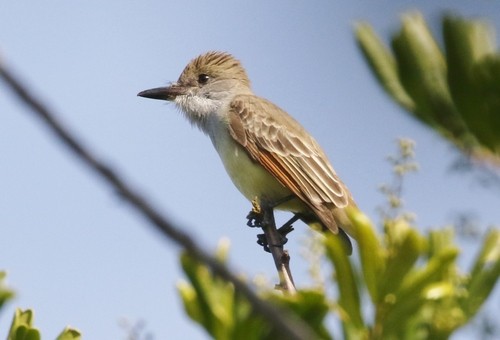Brown-crested Flycatcher
A species of New World Crested Flycatchers Scientific name : Myiarchus tyrannulus Genus : New World Crested Flycatchers
Brown-crested Flycatcher, A species of New World Crested Flycatchers
Botanical name: Myiarchus tyrannulus
Genus: New World Crested Flycatchers
Content
Description General Info
 Photo By silversea_starsong , used under CC-BY-NC-4.0 /Cropped and compressed from original
Photo By silversea_starsong , used under CC-BY-NC-4.0 /Cropped and compressed from original Description
Adult brown-crested flycatchers are 20.3 cm (8.0 in) long and weigh 30 g (1.1 oz) and have heavy bills. The upperparts are olive brown, with a darker head and short crest. The breast is grey and the belly is lemon yellow. The brown tail feathers have rufous inner webs, the remiges have rufous outer webs, and there are two dull wing bars. The sexes are similar. The brown-crested flycatcher is best separated from other confusingly similar Myiarchus species by its call, a rough loud "come HERE, come HERE" or "whit-will-do, whit-will-do". 
Size
22 cm (8.75 in)
Life Expectancy
8-11 years
Nest Placement
Cavity
Clutch Size
2 - 7 eggs
Incubation Period
1 brood
Feeding Habits
Brown-crested Flycatcher's diet mainly comprises insects and arthropods, captured in flight and often from the canopy. Brown-crested Flycatcher displays hunting agility, catching prey in a swift hover-and-snatch maneuver and consumes it perch-sited after processing. Occasionally, brown-crested Flycatcher supplements its diet with small lizards, hummingbirds, and, during winter, various fruits and seeds.
Habitat
Brown-crested Flycatcher resides in varied ecosystems such as arid deserts, sycamore canyons, riverine woodlands, and suburban areas with water bodies. At elevations up to 6,000 feet, their adaptable nature allows them to nest in mature woodlands, thorn forests, and second-growth as well as mangrove forests across broader Central America.
Nest Behavior
Brown-crested Flycatcher engages in nest building within chosen cavities. After constructing nests, egg-laying ensues, with parental care including both parents sharing incubation and feeding responsibilities for the young.
Nest Characteristics
Brown-crested Flycatcher's nests are located in tree cavities—natural, old woodpecker cavities, or nest boxes. They construct bowl-shaped nests at the cavity's base, using hair, fur, feathers, and frequently snakeskin.
Dite type
Insectivorous
General Info
Feeding Habits
Bird food type
Bird Feeder Type

Platform
Sounds
Call
Recording location: Mexico
Call
Recording location: Mexico
Song
Recording location: Mexico
Song
Recording location: Mexico
Behavior
Brown-crested Flycatcher exhibits territorial behavior, particularly during the breeding season. Males energetically establish and defend territories, which can vary significantly in size. The act of setting up a nest is prompt upon arrival at the nesting grounds, with a preference for reused woodpecker holes, where both males and females vigorously guard against intruders, even displacing other cavity-nesters if needed. The breeding pair collaborates in nest preparation, with females undertaking incubation and both sexes feeding the young. Post-fledging, the family unit remains cohesive for an additional month.
Distribution Area
The brown-crested flycatcher breeds in open woodland from southern California, southern Nevada, central Arizona, and southern Texas southward to Argentina and Bolivia, and on Trinidad and Tobago. It is resident in most of its range, but individuals breeding in the United States retreat to Mexico or southern Florida in winter. This species is a rather skulking insectivore which catches its prey by flycatching amongst the undergrowth. It sometimes eats fruit, such as the "gumbo-limbo", Bursera simaruba. The nest is built in a tree cavity or similar natural or man-made hole, and the normal clutch is two or three purple-marked cream eggs. 
Species Status
Not globally threatened.
Scientific Classification
Phylum
Chordates Class
Birds Order
Perching birds Family
Tyrant flycatchers Species
Brown-crested Flycatcher